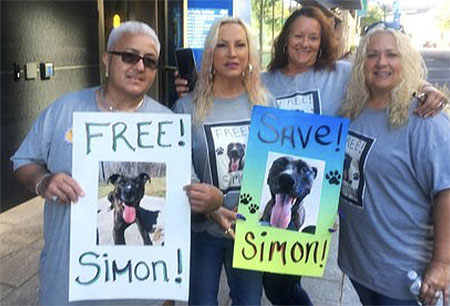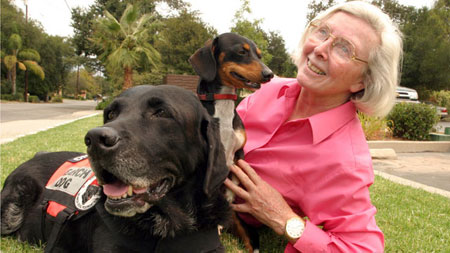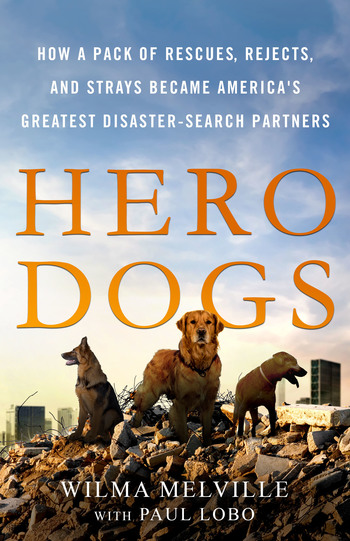Dog on Death Row
Dr. David Young & Simon
 One Connecticut family was heartbroken over their beloved dog Simon (a mixed breed) who was on death row, with their local town wanting to euthanize him.
One Connecticut family was heartbroken over their beloved dog Simon (a mixed breed) who was on death row, with their local town wanting to euthanize him.
Dr. David Young is an Emergency Room Physician in Connecticut and he had a dog-named Simon who is on Death Row.
Simon is a mixed breed dog that Dr. Young's family rescued in 2011 after Hurricane Irene in Connecticut. Simon was found abandoned. The Young family had Simon for years and he never left their property without one of them.
Unfortunately, one time when David and his wife were away, they hired a pet sitter who had known Simon for years. At the time, she was in the backyard-playing ball with Simon when all of a sudden a next-door neighbor teenager came through the wire fence separating the properties. David explains that they have both a wooden fence and a wire fence enclosing the property. The teenage boy then cut through the wire fence to gain access to the Young's property. He apparently did this to retrieve his lacrosse ball rather than just ask for the ball back.
The teenage boy came through the fence with his lacrosse stick and startled both Simon and the pet sitter. All of a sudden Simon noticed some strange person in the middle of the large backyard. Not surprisingly, Simon went after the boy and warned him with a nip to his shoe. The kid then raised his lacrosse stick in a threatening manner at Simon and Simon and bit him in the thigh. The kid then ran away back through the fence where he came in and Simon retreated.
It is not unheard of for a dog to bite someone when they are protecting their property. There was no doubt that this kid was trespassing, cutting the Young's fence and destroying their property. Unfortunately, the boy's family sought to seek revenge rather than come and talk to the Youngs. Most people are reasonable, especially with neighbors and might say, "Well, you know, kids make mistakes." However, the neighbors chanted, "Kill the dog, kill the dog!"
An animal control officer was called, who came to Simon's defense and said that Simon did no wrong and was just protecting his own property and that the kid trespassed.
Several days went by and the town had a secret meeting that the Youngs were not invited to. David says that at the meeting there were a couple of neighbors who had a chip on their shoulder and wanted Simon dead.
Previous to this, Simon had no prior offenses. He'd never been off his property. He did have one incident where a neighbor up the street was walking his dog off leash. The dog came onto the Young's property and Simon attacked the dog. But in this case, the boy was in the Young's yard waving a stick and threatening Simon.
Simon was then sent to the dog pound in the town of Guilford, Connecticut.
David explains that the first 10 pages of the police report have the animal control officer coming to Simon's defense. However, David says she was basically ordered to change her position. The animal control officer was inexperienced and she wanted to keep her job, so she therefore suddenly reversed her position after she originally defended Simon saying he did no wrong and he was on his own property.
David claims that there have been multiple dog bite cases in every state and every town, including Guilford, with dogs that were not provoked. But in this case, Simon was provoked. But even unprovoked dogs don't get put down. David explains that the difference is he has a neighbor who has political connections and has an agenda.
The town meeting was a private meeting, which is a violation of the open meeting law, and there were no minutes kept. This is illegal for a town to do. At that meeting, the decision was made to kill Simon. David explains that he and his wife were given this information by the chief of police. He met with them and said, you know, the decision has been made to put Simon down and you better not do anything or make any trouble. He basically threatened the Youngs. David thinks that he knew that basically they capitulated to a couple of noisy neighbors and thought it would just go away.
David says he thinks the teenager's family was hoping for a new Porsche and were hoping to cash in. However, David's home insurance denied their claim.
Dr. Debbie tells us that should be a big call out to David's community to change the way they handled this. In the community she lives in, there are actually Animal Advisory Committees that oversee animal bite situations. She even served on one for a period of three years. She says these situations are never cut and dry so there should never be one law with zero strikes. They actually have a three-strike rule in her town where if it were something malicious or something violent, it would be a totally different situation. But fortunately the cases are individually evaluated. However, when you have one person or even two people that make this level of a decision, it's unfair.
David tells us that there had been a lot of outcry over this and a lot of opposition to the town's handling of this. He says it's pretty obvious it was pretty political and underhanded. However, in the state of Connecticut, there are two laws. One is 22-357 that protects you and your pets on their own property in the case of trespassing, damage to property, etc. Simon's clearly protected on that. This is the basis upon which his insurance company denied the teenager's claim. But there's also law 22-358, and if you look it up, basically what that does, it gives the animal control officer wide latitude to make any decision they want, for any reason they want. And so that almost negates any kind of two or three bite rule.
David said he went to a hearing with the Department of Agriculture and said they are essentially in the same camp. They just rubber stamp whatever the town has already decided. It's a kangaroo court. It's not a real court. David then filed a Federal Lawsuit, trying to take it out of the Department of Agriculture into a real court, because in a real court, this will never stand.
Unfortunately what the Department of Agriculture keeps doing, is they keep throwing up smoke and mirrors and delay tactics. If Simon had bitten other people, David would be okay with their sentence, as he's not going to die on that hill. But in this case, it's just the principle and the seediness of the whole thing.
The town took over the expense of housing Simon while David bought his food and paid for his vet bills.
David visited Simon a few times a week and thought he was being treated okay. David says that he believes the animal control officer was conflicted, because she still hung out with Simon. She saw that he's not a threat. David felt she was in a position she doesn't want to be in. In fact, in the police report she said he's a friendly dog and he comes and plays. When David visited, he tried to be diplomatic and didn't raise any questions.
Fortunately Simon escaped death row and was moved to a shelter in Michigan.
Hero Dogs
Wilma Melville, National Disaster Search Dog Foundation
 The founder of the National Disaster Search Dog Foundation, Wilma Melville, shares stories of growing her nationally recognized organization by rescuing the dogs that would go on to rescue humans.
The founder of the National Disaster Search Dog Foundation, Wilma Melville, shares stories of growing her nationally recognized organization by rescuing the dogs that would go on to rescue humans.
Wilma Melville is a retired teacher and a grandmother. She could have just spent her time retired, but she ran into a 16-week-old Black Labrador Retriever that changed her life. The Black Labrador Retriever, who she named Murphy, was going to be in Wilma's life no matter what. However, she started working with Murphy and they trained together to become FEMA (Federal Emergency Management Agency) Certified. As a retired person she was looking for something active and purposeful to do and she had always wanted to learn to train a dog to do something special. She then chose disaster search thinking only of California and never knowing where that decision would lead. Shortly thereafter, they were sent to the Oklahoma City bombing in April 1995.
Murphy and Wilma became FEMA certified only about six months before the Oklahoma City bombing. Wilma found it to be a life changing experience when they were deployed to that bombing. She had no idea what was going on nationally, because her focus had only been California and was thinking of it as a hobby. However, when she was deployed with California Taskforce II, her eyes were open to the bigger picture.
At that time, our nation had approximately 15 FEMA certified dogs at that time. FEMA is the group that deploys task forces and dogs and handlers are a part of that task force. FEMA had developed 28 task forces in the nation. So Wilma was with one of them. Their assignment was to get on the air force plane with approximately 72 other people including firefighters, medical doctors, structural engineers, and off they went to Oklahoma City. Today there are approximately 285 FEMA certified teams today. In over 20 years it has grown nicely.
So where do these dogs come from? Wilma tells us that the shelters rescue the dogs. The National Disaster Search Dog Foundation primarily finds dogs in shelters and turns them from rescued to rescuers. Wilma explains that her foundation primarily looks in shelters for dogs. They look for high drive dogs, which means an active dog, a dog demanding a job. Typically the breeds are among the working group, German Shepherds, Golden Retrievers, Border Collies, Labradors and many Labrador mixes, as those are the kind of dogs that have the group of characteristics needed. But drive is primary. The dog that says, "I have to have a job. I have to have a job!" However, the job can vary. These are the dogs that are bomb dogs, drug dogs and sometimes even assistance dogs if they are on the mellow end, but dogs that need a job.
The National Search Dog Foundation has a video on their website. It's kind of lengthy, so you have to really be interested, but it shows the testing that they do to find the right dogs. While they test that the dog really, really loves a toy, they also test to see if it is driven. They don't want a dog that likes to play occasionally. They need a dog that is driven to have a toy because they use a toy so much in their work as a reward. Then the dog has to be willing to hunt for that toy. Hunt in the bushes and hunt among the brambles. Then the dog has to want to possess that toy and want to keep it. They time the dog for a minute, not paying attention to him, to see if he hangs on to and guards that toy and keeps his interest in it for the full minute.
In addition, the dog has to have a pretty solid personality and get along with other dogs and certainly get along with people. Then the dog has to not mind running over rubble, because it's not green grass were disasters happen. It's rubble, wood, concrete, metal, it's everything. The dogs that work best don't care and as long as their toy is involved, they'll go over anything. Those are the basics that they need. Wilma adds that if a person has a dog around two years age or less, which sounds like one of these potential candidates, they can call the National Search Dog Foundation office.
 When Wilma started the National Disaster Search Dog Foundation, which has now grown exponentially, she said there wasn't a budget. At first it was scratch around and try and figure out how to pay the bills. But, it turns out that in order to be a successful nonprofit, one must be just as good at asking people to join the cause and to donate, as you are at the mission. The mission of the National Disaster Search Dog Foundation is to strengthen disaster response in America. In order to do that mission, they need dollars. Many, many people have joined them. People have said that it's a good thing, because we do have disasters. We have earthquakes on the west coast. We have tornadoes in the center of the country. We have hurricanes on the east coast. People do want to be prepared for disasters, so they've pitched in and helped the organization build a national training center in Santa Paula, California.
When Wilma started the National Disaster Search Dog Foundation, which has now grown exponentially, she said there wasn't a budget. At first it was scratch around and try and figure out how to pay the bills. But, it turns out that in order to be a successful nonprofit, one must be just as good at asking people to join the cause and to donate, as you are at the mission. The mission of the National Disaster Search Dog Foundation is to strengthen disaster response in America. In order to do that mission, they need dollars. Many, many people have joined them. People have said that it's a good thing, because we do have disasters. We have earthquakes on the west coast. We have tornadoes in the center of the country. We have hurricanes on the east coast. People do want to be prepared for disasters, so they've pitched in and helped the organization build a national training center in Santa Paula, California.
When the dogs and handlers are activated with their task force and they are called out to an event in a particular state, typically the state will pay the bill. But if the state asks for emergency help because it's too big a deployment for them to handle, they then ask FEMA to get involved. So then it's largely federal money and some state money.
For example, the World Trade Center disaster was so huge that they used 27 out of the 28 Task Forces. Almost all of them were cycled through there over time. But there have been many hurricanes, including Katrina, and many other hurricanes to follow. FEMA is often involved in tornadoes. So the payment depends upon who initiated the task force. It could be your local, state, county or the federal government.
Wilma has a book that chronicles those years called Hero Dogs: How A Pack Of Rescues Rejects And Strays Became America's Greatest Disaster Search Assets. She hopes that people realize that a small group of people can get a great deal done. It takes tremendous perseverance and luck doesn't play too much of a role, but endless work and perseverance, knowing the direction you want to go. It also includes a tremendous army of people who say they will help, they will pitch in, they will write a check. Big or little, it's welcomed and appreciated.
Visit Website
Pheromones In Puppy Training - Dr. Debbie
 So you just got a new puppy and you have all your training tools at the ready, the collar, leash and dog crate. But beyond that, do you have the one thing that can make your training tasks easier all around? Tap into your puppy's own sense of smell using canine pheromones, and ease your new pup's training and transition into the home.
So you just got a new puppy and you have all your training tools at the ready, the collar, leash and dog crate. But beyond that, do you have the one thing that can make your training tasks easier all around? Tap into your puppy's own sense of smell using canine pheromones, and ease your new pup's training and transition into the home.
Pheromones are scent signals emitted by all animal species, including humans. Various pheromones work under the radar to influence the perceptions and behaviors of others within a species.
Shortly after whelping, a pheromone is emitted from the bitch's sebaceous (oil) glands located between the mammary glands. The pheromone, dubbed the canine appeasing pheromone, reassures the puppies, calms them and facilitates nursing. The bitch stops emitting this pheromone as the pups mature, but all dogs retain the ability to "read" this pheromone. Not only do older dogs recognize this pheromone, but it continues to have a natural calming effect on canines of all ages.
In veterinary behavior cases, the dog appeasing pheromone is used for dogs with noise phobias, car travel anxiety, separation anxiety, and other fearful situations. Various forms are available including pheromone collars, plug in diffusers and sprays. The canine appeasing pheromone doesn't sedate the dog; rather it decreases fear and excitability.
The dog appeasing pheromone is also helpful for newly adopted puppies. Those first few days to weeks in a new home are full of changes for the pup faced with novel environments far from the comfort of mother and siblings. The dog appeasing pheromone has been shown to ease the transition of the pup into new home and improve sociability and training during a pup's critical socialization period.
Pheromone Research
For skeptics that need to see the proof in the studies, veterinary behavior studies have examined the positive influence of the dog appeasing pheromone. When comparing treatment responses for dogs with separation anxiety, the use of the dog appeasing pheromone equaled the benefit of the anti-anxiety medication, amitriptyline.
One study looked at 66 puppies as they settled into new homes after adoption. Approximately half of the puppies wore a pheromone collar and half wore a placebo. The study found that puppies wearing a pheromone collar displayed significantly fewer nuisance behaviors like vocalizations or scratching within 3 days of adoption. Pups wearing the pheromone collar woke their owner's less during the night and displayed fewer signs of distress and vocalizations throughout the course of the study.
The researchers concluded that pheromone collars helped both the pup and family. Pups were less stressed and adapted easier. By decreasing the pup's stress and fearful behaviors, the pet owners found a more enjoyable bonding experience with the new pup and faced less frustration through the training process.
 In another study, puppies 8 to 15 weeks were enrolled in an eight-week long puppy socialization and training class. Half wore a pheromone collar and the other half wore a placebo collar. The pups wearing the collar were calmer in the face of novel experiences and displayed less fear, anxiety, and aggression. In the end, the pups with pheromone collar not only were less nervous, but had fewer behavioral problems and learned better. And a long-term effect on sociability was recognized in dogs up to one year after the class and study was completed.
In another study, puppies 8 to 15 weeks were enrolled in an eight-week long puppy socialization and training class. Half wore a pheromone collar and the other half wore a placebo collar. The pups wearing the collar were calmer in the face of novel experiences and displayed less fear, anxiety, and aggression. In the end, the pups with pheromone collar not only were less nervous, but had fewer behavioral problems and learned better. And a long-term effect on sociability was recognized in dogs up to one year after the class and study was completed.
Pheromones and My Pup
As the new owner of a nine-week old Bouvier puppy named Nikki, I used both the pheromone collar and diffuser upon welcoming my new pup home. One day before bringing Nikki home, I placed a pheromone diffuser close to the puppy crate, where it would have maximum benefit during her first nights in the kennel away from mother and siblings. Immediately upon leaving the breeder's home, Nikki was fitted with a pheromone collar to serve as a source of reassuring pheromones that went everywhere she did. The pheromone collar has become a tool in Nikki's socialization. It's on her when she meets new people or animals, when she explores new environments, and during puppy kindergarten class.
Did pheromones help in my pup's transition and training? The four hour drive home from the breeders was a dream, no crying or whining the entire trip. Now three weeks later from acquiring my pup, and Nikki never soiled in her kennel during the day or night. I'll admit I had my share of interrupted sleep in the first two weeks, but most of Nikki's night time wakes were for genuine elimination needs. Overall her transition into the home was smooth and lacked the wailing, inconsolable cries of a stressed pup.
The canine appeasing pheromone isn't a magic bullet though. Nothing matches a quality pup obtained from a reputable breeder who focuses on health, genetics, and early socialization. Likewise pheromones do not replace the hard work and consistent training efforts that any new pet owner must provide. However, by adding the the canine appeasing pheromone to your new puppy training, you can help your pup become the best he or she possibly can.
For more information on the DAP products, visit CEVA.
Featured veterinarian known as "Dr. Debbie" on national pet radio program, Animal Radio. Ebook author of "Yorkshire Terriers: How to Be Your Dog's Best Friend"; "Pugs: How to Be Your Dog's Best Friend"; "Mini Schnauzers: How to Be Your Dog's Best Friend"; and "Shih Tzu: How to Be Your Dog's Best Friend." Dr. Debbie's books.
Visit Website
Animal Radio News - Lori Brooks
 People Put Their Pet's Health First
People Put Their Pet's Health First
More than half of dog moms and dads put their pet's health above their own, according to a study. Sixty-two percent of the pet parents who were interviewed said they were most concerned about nutritional benefits when buying dog food. Fifty-five percent said a healthy diet for their dog is of the highest importance to them. But sadly, the experts found we don't always consider the health benefits of our own food. Overall health was the most important factor for those in charge of feeding their four-legged friends, closely followed by brand and cost. However, when shopping for ourselves, flavor gets the most consideration. Just a third of us consider the nutritional benefits of the food we're adding to our shopping baskets for our own consumption. And, although we shop for our pets with their health in mind, we could be doing more harm than good at home. Over a third of the dog parents admitted to feeding their fur kid chocolate and cheese, which in some cases can be extremely toxic. Only 68-percent claimed to know 'some' of the food items that are dangerous for dogs to consume.
Restrictions on Flying With Service Animals
Delta continues to further restrict its service animal policies, adding another rule that banned passengers from bringing any emotional support animals on flights longer than 8 hours. Delta says their updated rules support the airline's commitment to safety and also protect the rights of customers with documented needs to travel with trained service and support animals. Delta, which transports close to 700 service or support animals a day, claims the updates were the result of an 84-percent increase in incidents involving service and support animals since 2016. Regardless of booking date, emotional support animals and animals younger than 4 months will not be allowed on flights longer than eight hours. Delta also changed its support animal policy by limiting the number of emotional support animals per customer to one and banning "pit bull type dogs" as service or support animals.
 Man Proposed With The Help of 16 Dogs
Man Proposed With The Help of 16 Dogs
Most people expect a ring, flowers and maybe even music at their dream proposal, but one California man surprised his girlfriend with all that plus 16 dogs for added effect. He asked his then girlfriend to go for a hike before getting drinks with friends one night. About 15 minutes into the hike, there were rose petals beneath their feet and a cappella group singing Motown and Disney classics, when he popped the question. Then while they were kissing, she had no clue that 16 dogs were released, which then ran toward her. All of the dogs were part of the groom's family dog's running group.
Pet Prenups
Many couples these days are using prenuptial agreements to decide who gets the pets in the case of a future divorce. Legal experts say the number of couples deciding who keeps pets ahead of time is growing. And, there are even free online versions of pet prenups for couples to easily sort out their plans for the future. If you've missed your chance to draw up a prenup for your pooch and worry your partner could take it away someday, there are methods to improve your chances in a canine custody dispute. Whoever takes care of the pet, took them to the vet and paid for the pet's supplies and vet bills will stand a better chance of gaining custody, especially if you can prove it in court. Ultimately, your strongest claim to a pet is being its legal owner on the paperwork. Without a prenup to easily settle the dispute, dogs are considered "property" in the eyes of the law, so your name on the paperwork is the best proof that the dog is yours. It's good news that some states are beginning to account for pets differently in divorce proceedings. New York is perhaps the most progressive state when it comes to pet custody, letting judges account for "what's best for all," including the pets themselves.
Economic Barriers To Veterinary Care
In the past four years, nearly 28-percent of households experienced barriers to veterinary care, according to a national survey conducted by the Access to Veterinary Care Coalition. Dogs and cats living in lower-income households and with younger pet owners are most at risk for not receiving the vet recommended care. The biggest barrier for all groups of pet owners and all types of care is financial, with 80-percent being unable to obtain preventative care due to financial constraints. Another 74-percent couldn't afford care when their pet was sick.
 Airlines Denied Flying Fish
Airlines Denied Flying Fish
A young woman who tried taking her pet Beta fish with her onboard a Southwest was surprised when the airline would not allow her to board with the fish. Airlines are taking a hard line stance on animals, obviously animals of any type, in the cabin. Delta, which no longer allows pit bull type dogs in any capacity has further tightened its rules for service and support animals by not allowing them on flights longer than eight hours. But this young woman was able to take her flight and save her pet because she found a volunteer who was flying on another airline that allows fish who took the fish bowl for her to her destination city. We hope the fish's trip was more comfortable than a cat in Canada had when its owner didn't realize the cat was napping in a box she was getting ready to ship. The cat was accidentally shipped in a box to a customer 750 miles away. A group of volunteer drivers got the cat back home in time for Christmas.
 Listen to the entire Podcast of this show (#1133)
Listen to the entire Podcast of this show (#1133)





